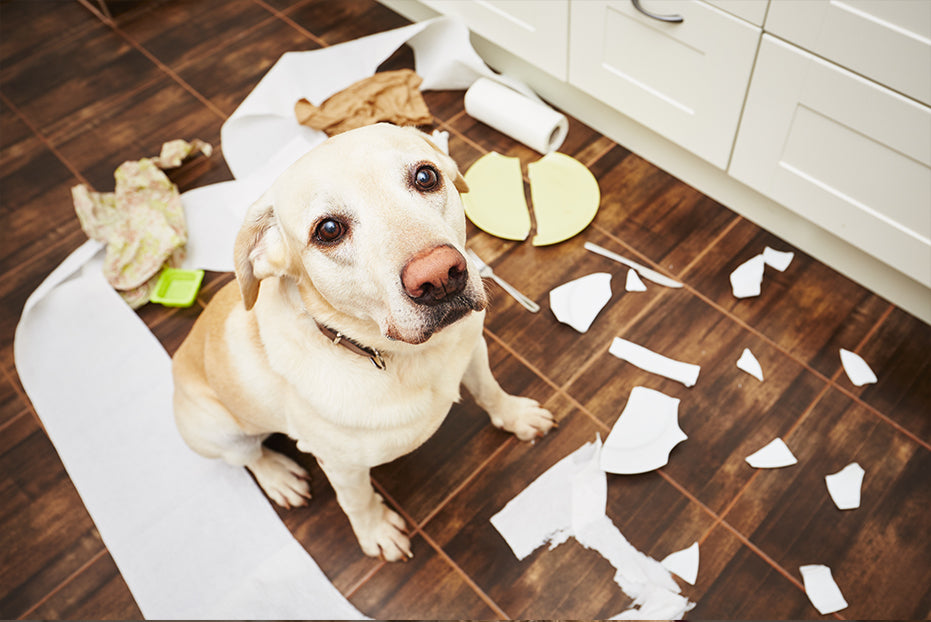
Recognizing Separation Anxiety in Your Dog
As the Summer of 2021 is starting to wind down, one thing is certain- for many pet owners returning to the office is on the horizon. About 280,270 dogs were adopted last year during the heat of the COVID-19 pandemic and most of these dogs do not know life without their owner being home almost all of the time. As we approach the return of normal, we have to think about how much of an adjustment this new way of living is, and how it is going to affect our pets. Whether we like it or not, most pets will have some form of separation anxiety once their owners return to their offices or begin socializing as they had before the pandemic.
Separation anxiety in dogs can sometimes be tricky to identify, but don’t fret, ThunderWorks is here to save the day (and hopefully your home) when you start spending more time away from the house. The first thing we need to do is take a look at exactly what separation anxiety is before we dive into how you can better assess if your pooch is undergoing separation anxiety or something else.
What is Separation Anxiety?

Separation anxiety is triggered when dogs become upset because of separation from their owners. Unfortunately separation anxiety is on the rise in dogs due to the lockdowns in 2020. Our dogs have gotten extremely used to spending a lot of time at home with us, but, in the near future that may change. Many of us are returning to the office and increasing our social activity as more and more things continue to open up, worldwide.
What are the Signs of Separation Anxiety in Dogs?

You may have noticed that your dog is already struggling when you go out for groceries or dinner and may be engaging in unwanted behavior in your absence.
Tackling this issue takes time and is something you want to work on ASAP (and early if possible). It takes a combination of many things, a training plan, distraction tools, tasty treats, ThunderEase, and more!
Urination and Defecation When Alone

Is your pup leaving some unwanted surprises for you when you leave them at home alone? If so, this could be a sign that your pup is having a hard time navigating life when you are not around. On the flipside, if your dog is urinating or defecating in the home while you are around, there might be something else going on. Make sure to check with your vet if you notice any changes in your dog’s behavior..
Barking and Howling

Have your neighbors started filing noise complaints against you when you are not home? Chances are your dog may be giving your neighbors an unwanted concert due to their separation anxiety. This type of barking and howling is only triggered by being left alone, but if you are seeing this at other times, there may be more going on.
Chewing and Other Destructive Behavior

Some dogs with separation anxiety chew on furniture, door frames or window sills, dig at doors and doorways, or destroy household objects when left alone. These behaviors can sometimes result in self-injury, such as broken teeth, cut and scraped paws or damaged nails. If a dog’s chewing, digging and destruction are caused by separation anxiety, they don’t usually occur when you are at home. Be sure to take note of when this destructive behavior does and does not occur so that you can definitively say that your pet is struggling with separation anxiety.
Do you have an Escape Artist on Your Hands?

A dog struggling with separation anxiety may have recently become an escape artist. Are you coming home to your pet no longer confined to their crate? If so, odds are high that your pet does not want to be alone.
Is Your Dog Exhibiting the Signs of Separation Anxiety?
It is common for dog owners to assume that their dog has separation anxiety when in fact their dog is just bored, not fully potty trained, barking because of activity outside the house or a slew of other reasons. Some owners may even think their dog is behaving out of spite or annoyance at being left alone. It is always best to discuss any change of behavior with your vet just in case.
If your dog is ONLY exhibiting undesirable behavior when left alone, it’s important to realize that your dog is not giving you a hard time – they are having a hard time.
What Can I do to Help Reduce Separation Anxiety for my Dog?
Check out these 4 tips to help reduce separation anxiety for your dog.
As dog calming experts, we are always here to help! If you have any questions, you can reach us at service@thundershirt.com or give us a call during business hours at (866) 892-2078.
 Skip to content
Skip to content
